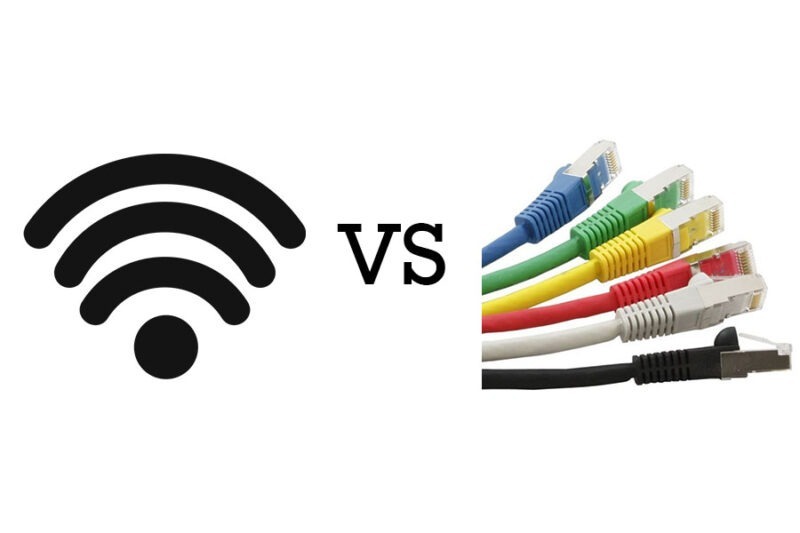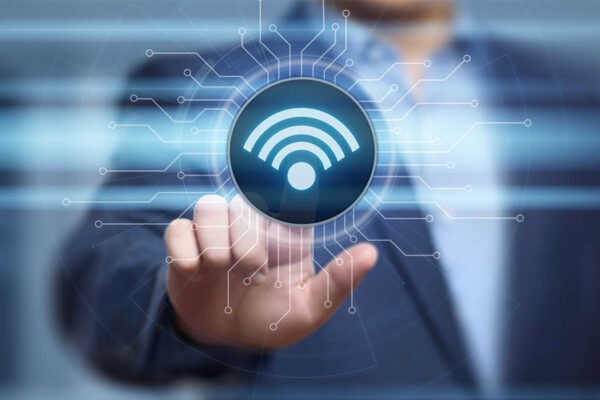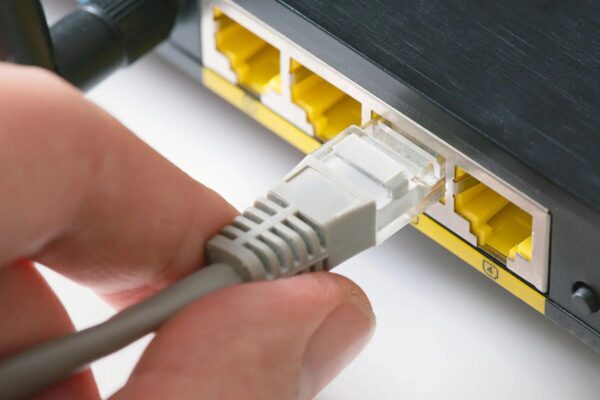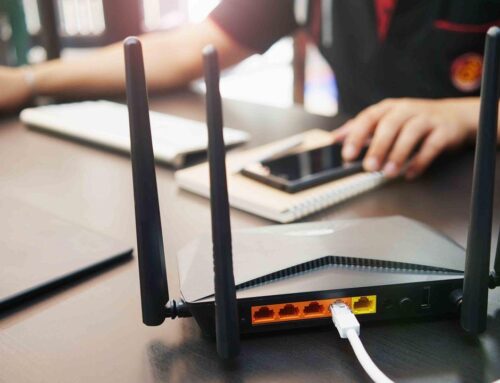Wi-Fi and Ethernet connections are the two main ways businesses can gain internet access. But what is the difference between WiFi and ethernet? WiFi, an abbreviation for wireless fidelity, uses radio waves to facilitate high-speed internet without cables and relies on a wireless adapter that creates hotspots using small antennas. Multiple electrical devices can connect to a single Wi-Fi network.
Ethernet uses a Local Area Network (LAN) and was first standardized in the 1980s. With Ethernet, an internet cable must physically connect to each device to transfer data. Your internet service provider most likely offers both Wi-Fi and Ethernet.
Below we cover how Ethernet cables and wireless devices connect to the internet, as well as a side-by-side comparison, the main differences of each and a definitive answer of which connection is better suited to business.

Understanding Ethernet Connections
Many companies have traditionally relied on Ethernet ports to tether a router to other devices because of the speed and stability it traditionally offered. However, Wi-Fi has evolved significantly over the years and now makes more sense in most cases.
Types of Ethernet Connections
There are generally two types of Ethernet used in offices across the world:
- Fast Ethernet: This type of Ethernet provides a high internet speed of up to 100 Mbps.
- Gigabit Ethernet: For organizations that require faster speeds for highly advanced tasks and regular video streaming, Gigabit Ethernet can deliver a consistent speed of around 1 Gbps.
Pros of Using Ethernet Cables
The benefits of using a wired connection to connect to the internet include:
- Speed: Because Ethernet uses a cable to instantly transfer data, it’s traditionally faster than Wi-Fi, which uses radio waves. However, the latest Wi-FI standard offers speeds up to 3,200 Mbps — more than enough for most companies’ requirements.
- Stability: Since Ethernet connects devices using a cable, the connection is stable and there’s no chance of dropped signals.
- Security: Ethernet lets you control who can access the LAN, making it much more difficult for hackers to exploit and steal data, although it’s still possible.
Cons of a Wired Ethernet Connection
While wired connections provide a stable speed and decent security, Wi-Fi connections can easily be tailored to match or exceed their specifications. Ethernet has a range of other disadvantages compared to a wireless network:
- Cost and scalability: Wired Ethernet connections require a lot of equipment to install and maintain. If your business is ready to scale up, expanding your network could be costly and time-consuming.
- Access: Adding users to your company’s network is significantly more challenging than with wireless internet. What’s more, mobile devices often don’t have the necessary ports or cables to facilitate Ethernet connectivity.
- Mobility: Ethernet requires devices to be hardwired together, so it’s not as portable or convenient as Wi-Fi.

Using Wi-Fi Connections
Wi-Fi is a form of wireless networking technology that grants wireless internet access to desktops, laptops, tablets, mobile phones and smart devices.
How a Wireless Internet Connection Works
Wireless internet relies on radio frequencies (2.4GHz or 5GHz) to transfer data between a router and wirelessly connected technology. Devices have a built-in wireless adapter, a Wi-Fi card, which receives radio waves and grants internet access. A router serves as the access point, sending out radio frequencies via antennas and broadcasting them to the devices in your workspace. The devices’ wireless cards receive the signals and connect you to the internet.
Wi-Fi Standards
Wi-Fi devices use a set of standards to communicate with each other. Wireless LAN is classified under the Institute of Electrical and Electronics Engineers’ (IEEE) 802.11 standards.
Most devices now adhere to 802.1ax, 802.11ac and 802.11n standards. However, the most cutting-edge Wi-Fi protocol is Wi-Fi 6, which relies on standard IEEE 802.11ax and is much faster than any previous iteration.
Wireless Access Security
While you might find a lot of articles that claim Ethernet is more secure than Wi-Fi, many of these are outdated. Wi-Fi is continually evolving, and there are more security protocols in place than ever to protect your devices against cyber threats. The two most recent Wi-Fi security protocols are:
- WPA2: This protocol was created in 2004 as the first iteration of the Advanced Encryption Standard (AES). It’s so secure that the U.S. Government approved AES to protect its top-secret information.
- WPA3: Used by all devices manufactured since 2019, WPA3 is the latest Wi-Fi security protocol and the most secure. It relies on even more advanced encryption technology to protect data, and the encryption speed is also faster than WPA2.
Types of Wi-Fi Networks
Types of Wi-Fi networks include:
- Traditional Wi-Fi router-based connections
- Mobile Wi-Fi hotspots
- Portable Wi-Fi hotspots and routers
- Satellite internet

Key Differences Between Wi-Fi Networks and Ethernet
Here’s a summary of the main differences between an Ethernet and a Wi-Fi connection:
- Wi-Fi delivers constant access to data across multiple devices, including tablets and mobile phones, which is ideal for high-productivity environments.
- With Wi-Fi-enabled devices, people can access the internet from several locations.
- Ethernet connections rely on cables and ports, which restricts mobility and access to mobile devices.
- Ethernet cables take up space and require maintenance, while Wi-Fi is significantly more flexible.
- You can create networks among small groups with wireless technology, making quick ad-hoc meetings across the globe easy.
- Ethernet connections provide a stable connection, which speeds up the process of downloading large files.
Why Choose Wi-Fi Connections?
For the vast majority of offices, the pros of Wi-Fi access far outweigh the cons. In increasingly hybrid workplaces where people rely on mobile electronics, it’s infinitely more convenient and practical. Many of the security and speed differences between Wi-Fi and Ethernet can be offset by implementing cybersecurity measures that would also be recommended with a wired connection.
Below are six advantages of using Wi-Fi in your office.
1. Access to Mobile Devices and Smart Devices
It’s impossible to connect a smartphone, smart speaker or smart surveillance camera using an Ethernet cable. What’s more, any business partner or client who visits your premises can enjoy the convenience and ease of using your wireless connection. Employees can access information simultaneously on any of their devices and work efficiently and effectively.
2. Collaboration and Productivity
Your employees need internet access during meetings, to communicate with remote workers and to view interactive presentations. This is practically impossible with an Ethernet connection but easy with Wi-Fi.
3. Speed
For a long time, Wi-Fi relied on standard 802.11g and its maximum theoretical speed of 54 Mbps, which is why many people still associate it with slower speeds than Ethernet. However, the latest protocol, 802.11ac, delivers speeds of up to 3,200 Mbps. Unless your company is live-streaming 24 hours a day, there’s a slim chance you’ll need higher speeds.
4. Scalable
Wireless connections don’t require costly installation if your business grows and you need to introduce new infrastructure. This makes it ideal for small to mid-sized businesses that are working towards future growth.
5. Customer-Friendly
Many POS systems, smart devices and advanced software systems let employees interact with customers unlike anything we’ve seen before. This allows your company to gather vast amounts of data about your customers in view of personalizing their experience to deliver superior customer experience.
6. Boost Sales
By improving customer experience and boosting productivity, an increase in sales naturally follows. What’s more, offering customers free Wi-Fi could increase the amount of time (and money) they spend while at your premises. They’ll also walk away with a positive outlook on your company thanks to the convenience free Wi-Fi affords them. All of the above makes clients more likely to come back and recommend your services to other people.

Wireless Technology in the Office
Having Wi-Fi enabled technology in your office or customer-facing store is beneficial to your company, its employees and its customers. You can improve the service you deliver to customers and gain a competitive edge in your industry.
Below is some additional information about using Wi-Fi in your office.
Simple Infrastructure
With a wireless workplace, it’s easy to organize staff and their devices, whether you provide them or operate with a BYOD policy. Wires and cables don’t dictate how you arrange your office, welcome new employees or assign desk locations. You can drastically reduce the amount of cables needed in your office, saving time and money on maintenance and improving the overall aesthetic of your workspace.
Superior Storage Solutions for Wireless Connections
Eliminate expensive and volatile server rooms by moving storage to the cloud — which is only possible via a Wi-Fi connection. Wireless hard drives and cloud-based storage are affordable and secure ways for your team to save and access files from anywhere in the world.
Use Wireless Devices for Security
These days, the best security systems and cameras are smart wireless devices. They’re extra-effective because you can install them anywhere and move them around or add more as needed.
Let EIRE Systems Take Care of Your Wireless Network
The future of business is wireless. We’re an independent provider of professional IT services to the finance, insurance and multinational sectors, operating across the Asia Pacific region. Countries we serve include Japan, Hong Kong, Singapore and China. Come to us for IT support, IT security, project management, cloud solutions and more.
Let EIRE Systems design your wireless networks for maximal efficiency and productivity so you and your IT team can do what you do best. Get in touch today to find out more.
About the Author: EIRE Systems
EIRE Systems is a leading independent provider of professional IT, AV and Access Security services to the financial, insurance, manufacturing, health care, retail, construction, hospitality, commercial real estate, legal, educational and multinational sectors in Japan and throughout the Asia Pacific region. EIRE Systems has expertise across a wide spectrum of Information Technologies, with a track record for successfully completing hundreds of assignments since its establishment in 1996.



